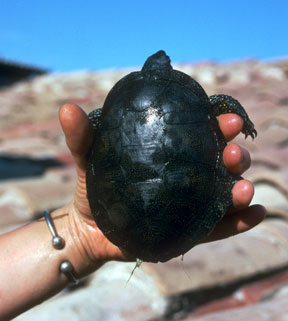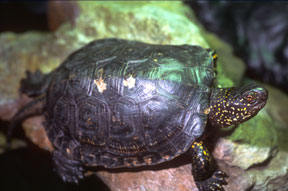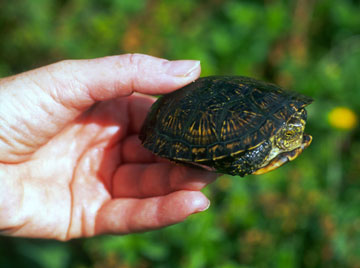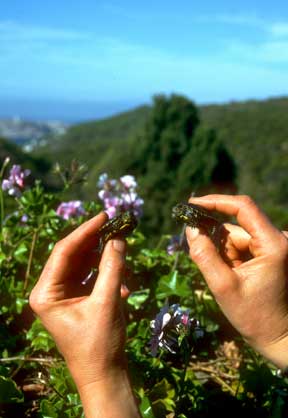
BREEDING EMYS ORBICULARIS IN CAPTIVITY (The European Pond Turtle)
Andy C. Highfield

The European Pond turtle (or terrapin)
has a wide distribution throughout continental
Today, it
is found in freshwater ponds and streams in
Taxonomy
The classification of Emys orbicularis is in something of a
state of flux, with 13 subspecies in five subspecies groups having been
described or resurrected in recent years. It is clear that marked regional
differences in size, colouration and marking occur. At present, there is much
debate as to the validity of these various races or subspecies. From a
practical point of view, until this is resolved, the best advice to keepers is
to maintain groups from known localities separately, and to breed only from
those that closely match each other in physical characteristics.
Reproductive
behaviour
Sexual activity in captive E. orbicularis is reported to begin in
nature at 3 to 4 years of age, although captive examples mature much
earlier. The breeding season in the wild
extends from early spring until May or June, with marked regional variations.
Courtship is usually initiated by a frontal approach, followed by the male
biting the face and neck of the female. Finally, copulation occurs. Oviposition
(nesting) typically follows within 4 to 6 weeks. Most nesting occurs in June or
July, though it may be earlier in some localities. The number of eggs appears
to depend upon the size of the female; typically, 3-5 eggs are laid, though as
many as 16 have been reported. The eggs
are elliptical, with soft, pliable and leathery shells. The females maintained
by the author lay an average of 4 eggs per clutch, and may nest twice per year.
Nests are usually excavated in loose, peaty soil, and often among the roots of
plants.

An adult basks under a UV-Heat lamp
Incubation
and hatchling care
The eggs of E. orbicularis are reported
to be highly reliant upon TSD, or Temperature Determined Sex. At temperatures
of 24-28 C, only males are produced, but at a temperature of 30 C 96% of
hatchlings are female. We have not had the opportunity to verify this, as all
of our hatchlings to date have resulted from nests that were not incubated in a
controlled environment. The females simply nested in the land area of their
pond which is situated in a covered greenhouse. The eggs incubated there, quite
successfully, at ambient temperatures, which ranged from extremes of 16 C to 32
C. In one instance, we were not even aware of the existence of the nest until
we spotted what appeared to be a large beetle wandering around the enclosure!
The “beetle” turned out to be a freshly hatched Emys orbicularis. Since then, our group on European pond turtles
has bred regularly and our first generation are now beginning to engage in
mating behaviour of their own, so a second generation success with this species
may not be too far off.

A captive-bred juvenile reared by the author
Environment
Both adults and juveniles do well in
surface-mounted ponds, or in standard pre-formed ponds sunk into and earthen
substrate. For juvenile ponds, we find a submerged Fluval 4 canister filter is
quite adequate to ensure good water quality, particularly when an airstone and
air pump is also added to boost oxygen levels and to help prevent stagnation. A
basking spot is mandatory, and we have found that the self-ballasted mercury
vapour lamps such as the UV-Heat range are ideal for use with this species.
Emys orbicularis are very susceptible to calcium and D3 deficiency problems, so
anything that promotes D3 synthesis is welcome. The water in the indoor ponds
is changed every 2-3 weeks, and this also appears to promote reproductive
activity almost immediately in response.

Two hatchlings
Diet
Emys
orbicularis are omnivorous, with juveniles initially
feeding upon insect larvae and small earthworms. We have also observed our
juveniles to feed upon floating duckweed and other aquatic plants. We provide
our standard aquatic turtle fare of mixed Reptomin sticks, rehydrated dried
trout chow, rehydrated low fat dried cat food (in limited quantities) and free
access to floating pond plants or salad. We dust all dried foods prior to
hydration with a phosphorus-free calcium and D3 supplement, and also regularly
provide chunks of cuttlefish bone for the turtles to gnaw upon. This they do
with great relish, and using this regime, no developmental problems have been
noted. Shell development is smooth and even.
In summary, Emys orbicularis are a highly attractive and interesting turtle, which appears to possess quite a high degree of intelligence. It is certainly very adept at exploiting any opportunity to escape, so good security is important. They are particularly skilful at climbing vertical surfaces. When maintained in good quality, secure environments, however, they are fascinating to watch, and captive breeding may occur with very little artificial intervention required!
(c) 2002-2003 Tortoise Trust